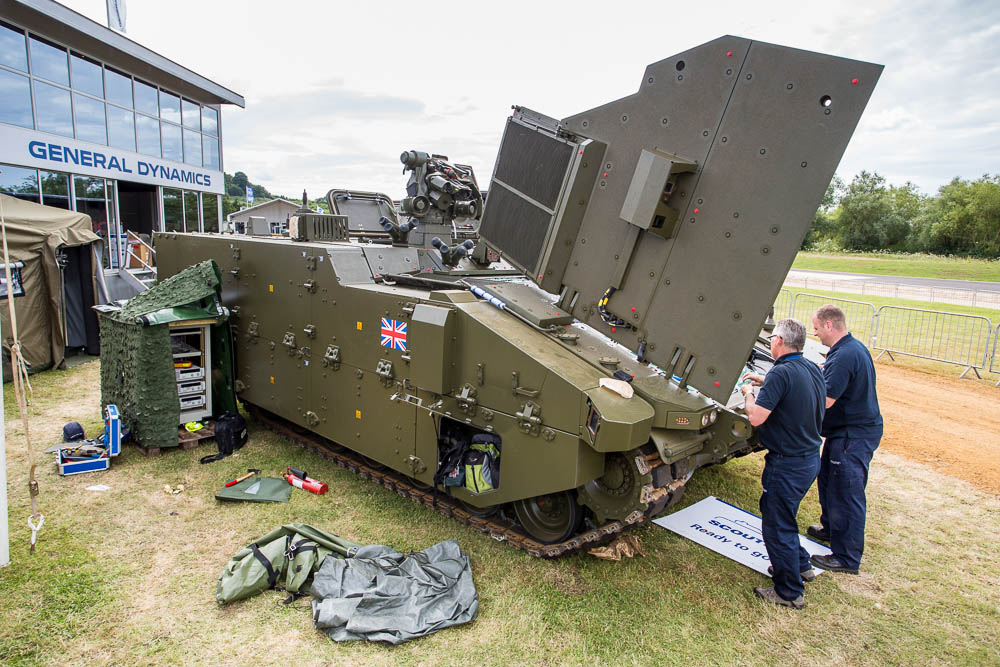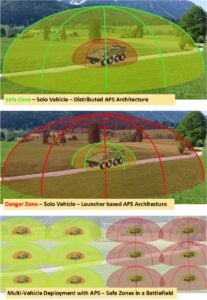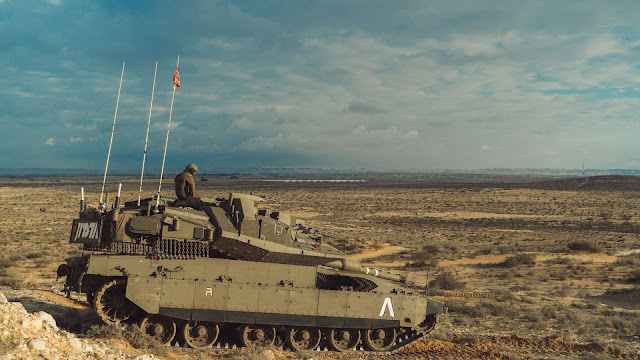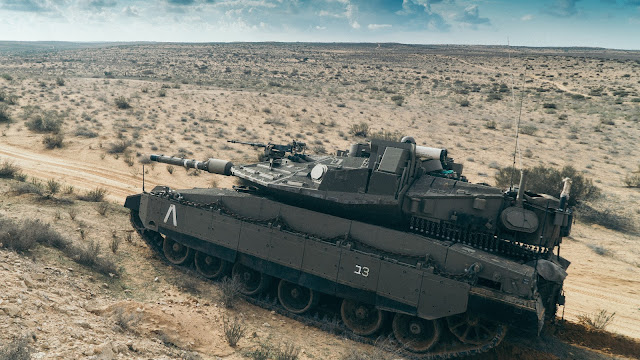
Mighty_Zuk
-
Posts
1,631 -
Joined
-
Last visited
-
Days Won
8
Content Type
Profiles
Forums
Blogs
Gallery
Downloads
Events
Posts posted by Mighty_Zuk
-
-
-
6 hours ago, barbaria said:
Could also be an M60 or sabra mbt. Anyway, this shows why hull ammo storage is faulty and bustle stored ammo with armored doors and blow off panels a la M1 is the best solution for mbt. Unfortunately the Altay also comes with ammo stored in the hull.
Best solution for an MBT with a human loader. The next generation of tanks will come with a robotized loader, and the ammunition will be separated from the crew. Much like the T-14 did. And you can still put the ammo below the turret ring in such a setup.
-
23 minutes ago, Militarysta said:
+ heavy damage Sabra:
I'm not sure that's what most would qualify as heavy damage. It puts it out of service for a while. Probably can't replace that on the field. But it's not a very thorough or very expensive repair.
-
45 minutes ago, Jägerlein said:
It seems like the Puma needs some Upgrades to be ready for VJTF in 2023. Following a report from Reuters the Bundeswehr expects that it will cost 500 million € to get 40 Pumas VJTF ready and supplied.
While the more mainstream nt-v newssite talks simply about 500kk €for upgrading 40 Vehicles, hartpunkt.de goes a bit deeper and explains that 1/3 of the sum consists of logistic costs for the mission, 1/3 for the development of new equipment especially an up to date digital radio system which enables the Puma to exchange sufficent data with other vehicles, drones, up to two dozent infantrymen and probably aircrafts to perform on the modern networked battlefield. The last third is then for the actual updates. While this sound stupididly expensive for 40 vehicles it includes the R&D costs so the ugrade of the remaining 300 Vehicles should (hopefully ) be significant cheaper.
) be significant cheaper.
The story in german:
http://augengeradeaus.net/2018/01/neues-vom-puma-millionen-nachruestung-fuer-die-vjtf/
https://www.hartpunkt.de/modernisierung-von-40-pumas-kostet-500-mio-eur/And what is VJTF, if I may ask?
-
That is... odd. The Trophy had no issue functioning in urban environment in 2014, and was said that rain does not cause it any issues, including false alarms.
-
46 minutes ago, asaf said:-snip-
It's been a rough winter this year. And these poor chunks of steel were sent to the freezing north.
Makes you just wanna cuddle them and say it's going to be alright

-
1 hour ago, SH_MM said:
Well yes, but how dangerous exactly is depending on what you look at. A Merkava 4 should have all-round protection against the basic PG-7V/PG-7M rounds fired by the the RPG-7, so in this case the APS adds additional danger to people (if the RPG-7 round hits the armor, there are a few fragments; if the RPG-7 round gets engaged by the APS, there are more fragments).
I think you misunderstood me. All APS, whether launcher based or not, ultimately strive to disarm the warhead. It would be no good if the warhead still detonated. If an RPG-7 hits, regardless of whether it penetrates anything or not, it will produce a great amount of fragments as well as a very strong blast that could cause hearing damage and concussion. If an APS disarms its warhead, the number of fragments itself will be far smaller, and they will be for the most part directed at a tight cone. A detonating RPG will cause fragments to fly in a chaotic manner.
What I am talking about is completely separate from the protected platform and its passive armor capabilities.
-
1 hour ago, LoooSeR said:
IDK, for me Merkava 4's Trophy module overall looks smaller than on Abrams
That's what I said...
-
2 hours ago, LoooSeR said:
1) i think armored housing of the system (those 2 big boxes on Abrams turret sides) are the reason of such weight. In Merkava 4 Trophy was installed inside of existing turret components.
2) At fist glance yes, Iron Fist looks to be better choice for light weight 8x8 APC. Is Iron Fist more dangerous for infantry?
1)That's not it. The Trophy on the Merkava doesn't cut into the armor modules, and has the exact same big boxes. It's just that because of the slope on the turret side on the Merkava it's more seamless.
It seems to me at least, that the Trophy module on the Abrams is larger than that of the Merkava.
2)Theoretically, yes. Because it has a detonation mechanism at the interception phase, and not prior like the Trophy/Iron Curtain/ADS. But it was chosen for the Bradley, which is also an APC/IFV, so the threat was perhaps seen as small. I also believe that APS are the lesser danger, as an ATGM/RPG detonating on the tank possess a much larger danger to surrounding infantry than an APS that defeats the warhead.
-
5,000 pounds and 5,700 pounds for the Trophy HV and Iron Curtain respectively? That's roughly 2.2 tons and 2.5 tons.
What on earth did they add there that increased the weight so much? Because the Trophy HV, as installed on the Merkava 4, or at least as advertised by RAFAEL, weighs ~800kg.
But nevermind that. The Stryker, which is the lightest platform and is most weight-sensitive, takes an additional 2.5 tons because of the Iron Curtain?
At least the Iron Fist LC didn't see any platform-related weight increase to its base system weight. Maybe it would have been a better idea to use the Iron Fist on the Stryker as well, and reinvest the weight in a new turret or better armor.
-
20 minutes ago, Ramlaen said:
Great stuff! From this angle we can definitely see the storage boxes are indeed only at the front section, just like @Serge said. Though the rear would arguably be a better placement.
-
-
2 hours ago, SH_MM said:

Yeah I remember now seeing this picture a while before. It doesn't make sense to use the entirety of the hull's size, on both sides, for storage. That's just a ridiculous amount of equipment they're carrying there. I definitely wouldn't want to be the guy that loses all his gear because some dude with an AK decided to have a little fun.
-
1 hour ago, SH_MM said:
I'm still not sure what to think about the Ajax platform. But I guess they now officially confirmed (for the second time), that the "side armor" modules are in fact storage boxes; otherwise there wouldn't be a need to adopt the net-based Tarian's RPG armour at the sides.

We could have misinterpreted previous infographics as stating these are storage boxes. They could be, but logically they wouldn't be nearly as big and extend all the way down, and all the way across the vehicle. It just makes no damn sense.
Still, regardless of what they are, net armor is not a confirmation of anything. It's just another layer of defense. Good for them.
-
12 hours ago, Andrei_bt said:
Your understanding of this is "pretty basic" as it was a parody to US and WW2 posters which someone take too seriously.
Understandable. Have a nice day.
-
All APS systems have a certain chance not to damage the warhead to the point where it's non-functional. Although in most cases a static launcher based system will attack the warhead from a certain odd angle and will increase the chances to damage the warhead, it still leaves a chance the warhead will fuze and the distance between the vehicle and warhead will be too little, which might make it more dangerous for LAVs.
And I side with Andrei on the last part. ATGMs and RPGs are more dangerous than APS.
-
31 minutes ago, Marsh said:
Just looking at a very small screen image, but that does look like a Merkava 3. If so, surprised that the 188th (Barak Brigade?) moved straight from the Shot to a later Merkava model.
Cheers
Marsh
The IDF is a very large military for Israel's population, as you know. Many brigades to feed with new tanks.
That is why Magach tanks were in service until 2014.
However what some dont know is that the IDF always keeps at least 1 active brigade with the oldest tank in the inventory. The 7th brigade only recently transitioned to the Mark 4M after using Mark 2, and now the 188th brigade is left with Mark 3.
This is done so that the tank crews wont have it too difficult when they make the transition to older tanks when they go in reserve. Going from a Mark 4 to a Mark 2 or Magach could be quite the shock. But a Mark 3 crewman downgrading to Mark 2 could quickly get used to it.
I think when the last Merkava 2 brigade will be transitioned, the 188th could finally upgrade to the Barak.
-
-
12 minutes ago, Militarysta said:
It's not all. Heavy version of AMAP-ADS is able to stop APFSDS-T even from 200m distance.
Somehow I have doubt it can do it at such distance. That would require a launcher-based system. The ADS uses static launchers.
As far as I know, the ADS is no longer marketed as capable of intercepting APFSDS, because none seems to want that, because it usually means the capabilities against ATGMs are degraded. Trophy turned into an SC-only system. Iron Fist Light Configuration, that lost the anti-KE capability also became the leading product IMI is marketing.
-
19 minutes ago, SH_MM said:
The whole "close-proximity APS are saver" discussion (and marketing) has been done since at least ten years, there are tests (and probably also studies) confirming this. How much the increased safety is valued by each potential user nation is different. In Germany, modern conventional ERA was invented (indepent from Soviet research), yet it was never adopted due to the increased danger for nearby infantry (a result of the metal fragments thrown formed by the ERA flyer plates upon penetration). Many other countries didn't care about it, German companies developed the CLARA (HL-Schutz) ERA. Yet CLARA was chosen for a €124 million contract by the UAE army, not one of the cheaper, more dangerous options...
I pretty much said that the real news here is about the certification, and that the concept itself remained the same. You and I basically agree on this one. But Germany not adopting ERA? Doesn't the Puma have ERA on its sides?
19 minutes ago, SH_MM said:As far as the APS market is concerned, I think you assessement is incorrect. The Netherlands are buying Iron Fist for tests first, a follow up order to equip more CV90s will come only if these tests are successful.
Australia might buy Trophy or any other APS. They have not decided yet and are also considering the ADS - don't forget that the ADS is mounted on one of the Boxer CRVs! Aside of an unnamed SEA country, Turkey is actively trying to buy the ADS (despite also developing their local APS called Akkor). The deal has been delayed by the German government, but it soon might be finalized (see my mention of the news report by the Spiegel magazine earlier). Germany is testing the ADS as possible option for the Boxer and Leopard 2. Furthermore three European countries (France, the UK and Sweden) have funded trials of the ADS in the past; none of these have yet decided to buy an APS - but if they do, would they buy a system already tested by their own military or buy something else? Who knows. Last but not least: The United States are interested in buying the ADS for tests. On the long run, the US Army will adopt its own APS, the modular active protection system (MAPS), which might incorporate technology from other systems. The current APS trials in the United States need to be put into the context of the MAPS, they are only used to tests the capabilities of current active protection systems and find out how the MAPS should look like.
Only Trophy (as urgent material requirement) will be adopted on actual combat vehicles, while the Iron Fist APS and the Iron Curtain APS will be used for tests.
And yet things have always worked out very differently from what you described.
Netherlands may or may not buy the Iron Fist, but if it will choose it wants a certain APS, it will go for what it already invested in. But let's leave that one for now.
RAFAEL had a pretty strong entrance into the Australian defense market. They set up a local branch just for the LAND program. Especially the LAND 400. Spike missiles and APS are at the front of their campaigns. And it gets a considerable amount of talk in there. Maybe they'll choose to go with ADS because it was already mounted on one, so they know how that looks and could even order tests more quickly, but there's also the factor of their modernization of Abrams fleet. The Abrams had already undergone an integration process for the Trophy.
Turkey might still favor the Akkor in the long run, at least for its Altays. And its design is in the same category as the Iron Fist. Again, bad for Rheinmetall when considering the path each country follows with their APS. ADS is only readily available for the Leopards.
France; I assume they would rather have a domestic APS. Or at least try to get their own ideas into the ADS if an iteration of it finds its way into the next-gen tank developed jointly by France-Germany.
Last but not least, the US has a long history of turning temporary solutions into long term ones. MAPS is indeed modular but it won't negate the high costs that involve installing an APS that is fundamentally different and requires both changes to the doctrine and changes of the exterior design of the tank.
It's pretty safe to say by now that they are going for Trophy for a long time, and the Iron Fist and Iron Curtain APS will share a similar fate.
19 minutes ago, SH_MM said:As for the ADS's performance, Jane's Defence Weekly reported the following in early 2017:
"The system has been tested successfully against a range of weapons, including the Russian Kornet and RPG-7 families, the US TOW 2B, and the Swedish BILL 1 and AT4 Confined Space (CS). Capable of firing even if the associated ROSY_L smoke dispensing system has been deployed, the ADS uses an infrared bandwidth that is lower than the multispectral smoke can obscure. The system has been subject to more than 800 live-fire tests, including three Kornet missiles, more than 535 RPG-7 series RPGs, and five top-attack TOW 2Bs. Threat detection and validation is reported by the company to be greater than 95%, while interception has been stated as 85–90% for anti-tank rockets and more than 80% for ATGWs.
The Active Defence System has already been sold to Malaysia (I assume they mean Singapore...) for use on its upgraded Leopard 2SG MBTs. ADS even claims it is more effective than rival hard-kill systems such as the Israeli Trophy because it is more effective at preventing detonation of the threat projectile’s warhead."(Please note that the current NATO standard STANAG 4686 for (active) protection systems demands only an 80% probability to reduce armor pentration by 50%)
Interception rate for ATGMs at 80%? That doesn't sound good. That would be 2 kills in an operation on the scale that happened in Gaza in 2014.
And how is probability of interception related to reduction in armor penetration? If it's on the 20% side, and fails to intercept, how does that reduce armor penetration?
-
https://breakingdefense.com/2018/01/rheinmetall-rolls-out-safer-active-protection-for-tanks/
http://www.janes.com/article/77272/iav-2018-ads-set-to-conform-to-safety-standards
ADS GmbH re-brands the ADS (formerly AMAP-ADS) as the 'world's safest APS' by applying its latest variant - the ADS-Gen 3 to the highest safety standards.
It does so by firing its countermeasures very close to the vehicle, rather than at a standoff distance. To make things clear; their concept of an APS always incorporated these safety features, but now it gets the appropriate certifications after the testing.
What Gen 3 brought to the table is new software that reduced its false alarm rates to a point where the chance of one is negligible at best. It's something RAFAEL has also been taking pride in, as of recent, saying that the Trophy has hundreds of thousands of operational hours with zero false alarms, and has passed a 4-year certification process in the IDF, in similar independent tests as the ADS went through. But Rheinmetall also claim their concept is inherently safer.
I'll quote the relevant bit to demonstrate that:
QuoteThere are two types of active protection systems, in Rheinmetall’s typology. The current world-leading system, the Israeli Trophy now being tested on US Abrams tanks, is a “launcher” type. It detects the incoming missile and launches a countermeasure, which intercepts the threat and detonates some distance from the vehicle. (See the video above).

Rheinmetall argues “launcher” Active Protection Systems that explode incoming missiles at a distance are less safe than “distributed” systems that destroy the threat close-in.
The problem with this approach, Rheinmetall argues, is it creates a big explosion some 30 to 40 feet away from the defended vehicle. That’s where friendly infantry are likely to be.
So “distributed” active protection system — like Rheinmetall’s ADS or DARPA’s Iron Curtain — instead puts small charges all around the vehicle (hence “distributed”). One of these charges then blasts the incoming missile at point-blank range just a fraction of a second before it impacts. Obviously that creates an explosion right next to the armored vehicle they’re protecting, but it’s not the highly focused, armor-piercing blast of an anti-tank warhead impacting the armor, so it’s generally safe for the vehicle.
It’s also generally safe for the infantry, who are trained never to accompany a friendly vehicle too closely because tanks draw a lot of fire. Likewise, during city fighting, civilians generally give tanks a wide berth. (A further safety feature is the distributed APS’s charges are usually positioned to shoot almost straight down, so any shrapnel is absorbed by the ground).
It’s hardly infallible, but it’s arguably safer to work with a vehicle you know occasionally gets engulfed by an explosion than with a vehicle that unpredictably blows up things at random directions and distances.
So now it is only a matter of time to see where the market of APS shifts, but the future is not very bright for ADS. While static launchers are indeed inherently safer, the margin of difference is not significant, at least from my understanding, and these safety features come at the cost of certain capabilities like standoff interception, which could come in use when the warhead still detonates, and group shared coverage (where one tank may defend another).
And because the US decided upon 2 launcher based APS already, Netherlands bought Iron Fist, and Australia may soon buy Trophy, only on the western hemisphere, is not good news for Rheinmetall because it shows a certain conceptual preference.
On the east, Russia's Afghanit and China's GL-5 pretty much speak for themselves.
-
2 hours ago, LoooSeR said:
Andrey's blog you mean?
Yes. Starting any article with how country X's propaganda is this and that, is unprofessional and in itself sends a message that the author itself wants to insert his own agenda in a disturbing way.
Now, Andrey is a knowledgeable man. So perhaps a rewording is due.
-
1 hour ago, Alzoc said:
You know me too well xD
But at least the Merkava do that while having actual armor on the turret sides (for the more recent versions at least) so it makes more sense.
Nah, not really. I mean, it does have quite a lot on the sides, but it doesn't cover the bustle which houses the ammo. So if a Mark 4 was hit from the same angle as that Leo 2, it wouldn't have much more armor covering its ammo. But both are pretty much immune to catastrophic kills from turret hits, due to blow-out panels existing on both tanks.
-
What's that on the Rosomak's front?





The Leopard 2 Thread
in Mechanized Warfare
Posted
What's not "cost effective" about the Armata's design?